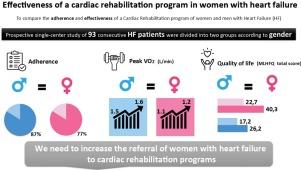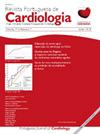Effectiveness of a cardiac rehabilitation program in women with heart failure
IF 1.6
4区 医学
Q3 CARDIAC & CARDIOVASCULAR SYSTEMS
引用次数: 0
Abstract
Introduction and objectives
The effectiveness of cardiac rehabilitation (CR) in improving exercise capacity and quality of life (QoL) in heart failure (HF) is well established. However, it remains underutilized in women. We aimed to compare the adherence and effectiveness of a CR program in women and men with HF.
Methods
This was a prospective single-center study of consecutive 93 HF patients referred to a CR program between September 2019 and July 2021. We defined adherence as the percentage of sessions patients attended. Effectiveness outcomes were changes in peak oxygen uptake (VO2 peak) and QoL measurements before (baseline) and after the CR program (12wk). VO2 peak was assessed by a maximal effort cardiopulmonary exercise testing on a treadmill. QoL was assessed using the Minnesota Living with Heart Failure Questionnaire (MLHFQ).
Results
Among 93 patients, 32.3% were female. Regarding adherence, 84% of patients completed the CR program, and no significant differences were found between groups (p=0.232). The increase in VO2 peak did not differ between genders (p=0.938). A significant reduction in the total, physical and emotional MLHFQ scores in both genders was observed (all p<0.05). There were no significant differences in QoL effectiveness analysis between the groups (all p=NS).
Conclusion
Women with HF adhered to the CR program similarly to men and had a similar increase in VO2 peak, a robust and validated prognostic marker for HF in this setting. Women benefited as much as men in all dimensions of QoL. Together, these data emphasize the need to increase the referral of women with HF to CR programs.

女性心力衰竭患者心脏康复方案的有效性。
前言和目的:心脏康复(CR)在改善心力衰竭(HF)患者的运动能力和生活质量(QoL)方面的有效性已得到证实。但是,妇女仍然没有充分利用这项技术。我们的目的是比较女性和男性心衰患者CR方案的依从性和有效性。方法:前瞻性单中心研究,在2019年9月至2021年7月期间,连续93例HF患者转入CR项目。我们将依从性定义为患者参加疗程的百分比。有效性的结果是在CR计划(12周)之前(基线)和之后的峰值摄氧量(VO2peak)和生活质量测量的变化。通过在跑步机上进行最大努力心肺运动测试来评估vo2峰值。生活质量采用明尼苏达州心力衰竭患者生活问卷(MLHFQ)进行评估。结果:93例患者中,女性占32.3%。关于依从性,84%的患者完成了CR计划,组间无显著差异(p=0.232)。VO2peak的增加在性别间无显著差异(p=0.938)。观察到男女患者的MLHFQ总分、身体和情绪得分均显著下降(均为p)。结论:HF女性患者与男性患者一样坚持CR计划,并且vo2峰值也有相似的增加,vo2峰值是在这种情况下HF的一个可靠且有效的预后指标。在生活质量的各个方面,女性的受益程度与男性相同。总之,这些数据强调有必要增加心衰妇女转介到CR项目。
本文章由计算机程序翻译,如有差异,请以英文原文为准。
求助全文
约1分钟内获得全文
求助全文
来源期刊

Revista Portuguesa De Cardiologia
CARDIAC & CARDIOVASCULAR SYSTEMS-
CiteScore
2.70
自引率
22.20%
发文量
205
审稿时长
54 days
期刊介绍:
The Portuguese Journal of Cardiology, the official journal of the Portuguese Society of Cardiology, was founded in 1982 with the aim of keeping Portuguese cardiologists informed through the publication of scientific articles on areas such as arrhythmology and electrophysiology, cardiovascular surgery, intensive care, coronary artery disease, cardiovascular imaging, hypertension, heart failure and cardiovascular prevention. The Journal is a monthly publication with high standards of quality in terms of scientific content and production. Since 1999 it has been published in English as well as Portuguese, which has widened its readership abroad. It is distributed to all members of the Portuguese Societies of Cardiology, Internal Medicine, Pneumology and Cardiothoracic Surgery, as well as to leading non-Portuguese cardiologists and to virtually all cardiology societies worldwide. It has been referred in Medline since 1987.
 求助内容:
求助内容: 应助结果提醒方式:
应助结果提醒方式:


